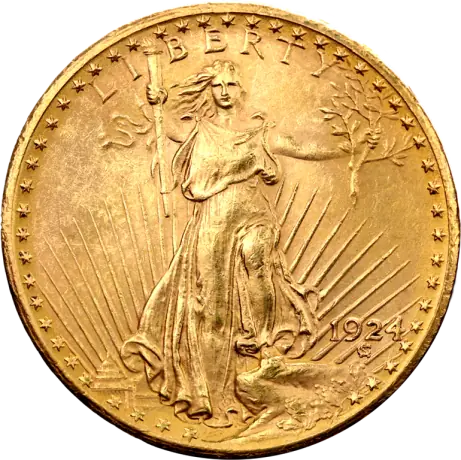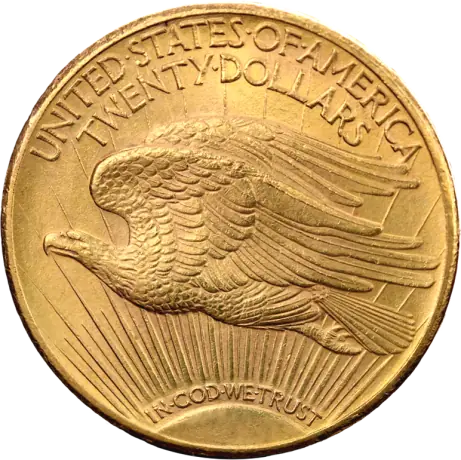20 Dollar Double Eagle "Saint-Gaudens" | Gold | 1907-1933
20 Dollar Double Eagle "Saint-Gaudens" | Gold | 1907-1933
The 20 Dollar Double Eagle, also known as the Saint Gaudens Double Eagle, was minted between 1907-16 and 1920-33. It results from a unique relationship between Augustus Saint-Gaudens, the most famous American sculptor of the 20th century, and US President Theodore Roosevelt, who was a true advocate of beautiful coins.
A statute of the Lady Liberty, which symbolizes the personified goddess of freedom, carries a torch in her right hand and an olive branch in her left. She walks forward surrounded by rays of sunshine, the word "Liberty" above her and the White House at the bottom left. Surrounded is the coin motif of 46 stars, one for each state at this time. The designer initials in the form of three superimposed letters "ASG" can be found below the date.
On the other side of the coin is the American heraldic animal, a bald eagle, depicted as a flying bird. Above, the inscriptions "United States of America" and "Twenty Dollar" can be seen in two semicircular steps. The saying "In God We Trust" was not placed between the sun and its rising rays until the end of 1908. Saint-Gaudens ordered the saying "E Pluribus Unum" („Out of many, one“) along the edge of the coin
Roosevelt and Saint-Gaudens intended to produce the Double Eagle coins using the high-relief embossing process. A few weeks before the first edition, the artist died. The notorious opponent of all Saint-Gauden's coins, the then chief engraver of the US mint Charles E. Barber, was finally able to prevail with a conventional embossing technique. Some of the high relief test stamps of that time still exist today and are recognizable, among other things, by the Roman numerals of the year for 1907 "MCMVII".
| Country | USA |
| Weight1 | 30,09g |
| Product number | 118217 |
| Series | American Eagle |
| Mint | United States Mint |
| Purity | 900/1000 |
| Currency | US Dollar |
| Face value | 20 |
| Product packaging | Sachet |
| Diameter, mm | 34.00 |
| Thickness, mm | 2.41 |
| Authenticity guarantee | No Certificate |
Buy back
Sell your bullion coins and bars back to us with hassle-free and secure buyback service.
Enjoy competitive rates based on real-time metal prices.
Why Buy from Us
- StoneX Group – NASDAQ-listed, global reach
- LBMA member
- Over 100,000 satisfied clients in the UK and Europe
- Real customer reviews




